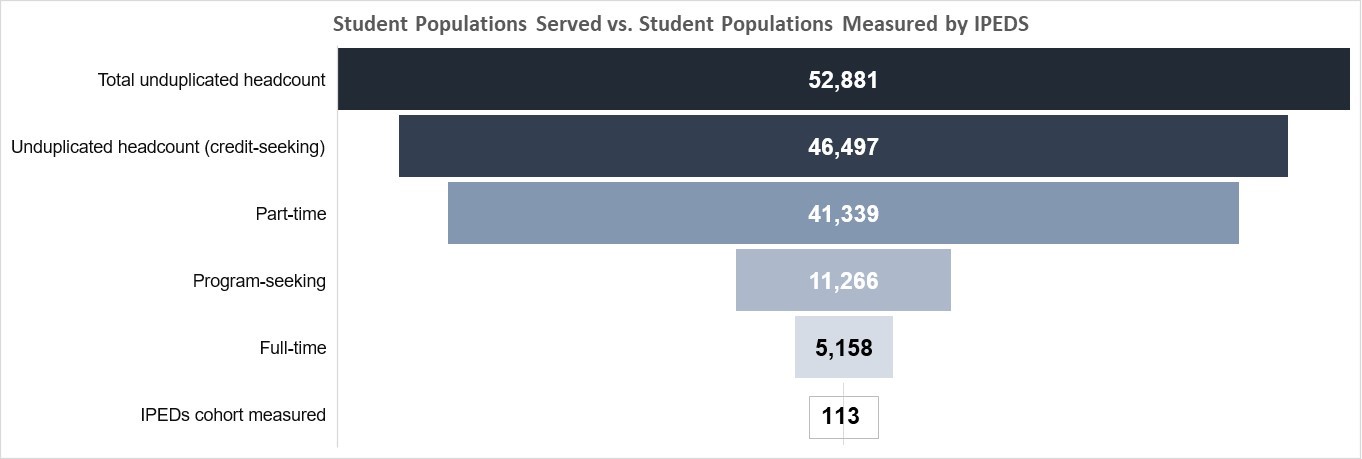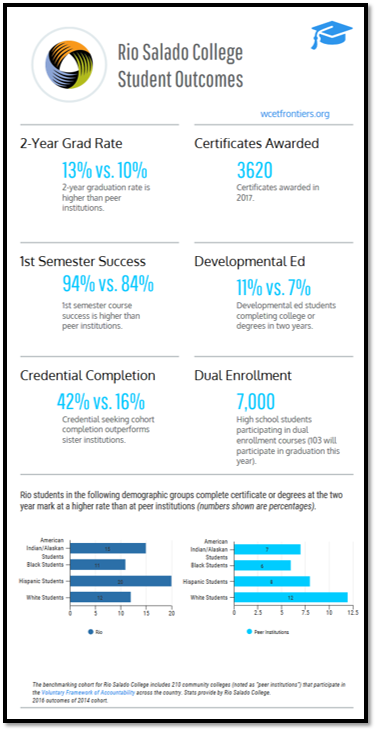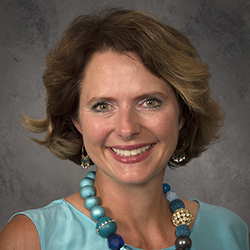Today here on WCET Frontiers we are happy to welcome Stacey VanderHeiden Güney, the Director of the Digital Learning Solution Network. Stacey is here to discuss a recent study on higher education institutions implementing digital learning and follow-up conversations regarding one of the institutions included in the study.
Thank you to Stacey for today’s post and a special thanks to the representatives from Rio Salado College, who held a wonderful conversation with us in preparation for this post.
Enjoy the read and enjoy your day,
– Lindsey Downs, WCET
Recently, Rio Salado College was one of six institutions who participated in a Bill and Melinda Gates Foundation funded study entitled “Making Digital Learning Work: Success Strategies from Six Leading Universities and Community Colleges.” The study “identified an initial list of approximately 50 candidate institutions cited as exemplars in the implementation of digital learning” (Please note this is the only place in the report where the word exemplar is used). There were some additional criteria in terms of size, scale, target population, and graduation rates. Rio Salado College (Rio) was chosen because of its unique model of serving its students.
A recent article in the e-Literate blog questions Rio’s track record in terms of aggregate academic student outcomes and how “appropriate it is to include them as an exemplar in such a case study-based report.” It went on to conclude that “at best, this is a school with mixed results that should not simply be labeled a success without caveats or explanations” and “whether it is appropriate to hold up a school with some of the lowest student outcomes measures in the country as an exemplar.”
Innovation is sometimes difficult to measure by traditional standards. In the case of Rio, the Department of Education’s Integrated Postsecondary Education Data System’s (IPEDS) Graduation Rate data represent only 0.4% of the college’s fall semester student population. With that in mind, we wanted to take the opportunity to speak with members of Rio Salado College, so they could provide some context. As Paul Harvey used to say, “the rest of the story” may be useful to the larger populace in understanding the unique and innovative model that Rio has created.
With the exception of this introduction and the Summary section, the following sections are responses to questions in an interview with Rio personnel as well as information that was provided to me via email. Participating in the interview were:
- Angela Felix, Faculty Chair for Languages, Faculty Senate President.
- Janelle Elias, Dean of Institutional Effectiveness and Innovation.
- Zach Lewis, Analyst in Office of Institutional Research.
- Kate Smith, Vice President of Academic Affairs.
WCET is pleased to give Rio Salado College this forum to explain their model and their outcomes.
What makes Rio unique? (What does Rio do and how do they do it?)
Our mission
Part of the uniqueness stems from the origin of the college. We were created to be the college without walls to bring education to both the underserved and the unserved. The history of Rio is pushing the boundaries of traditional education and traditional metrics. It’s incumbent upon Rio to be ready to answer scrutiny because it’s a different model.
Rio was built to reach populations that not all institutions can reach. We work hard to make education accessible to all students: adults, military, incarcerated, high school, business, international, and more. We’ve grown throughout the years; we started with providing education in storefronts in Arizona to being an early provider of online. We have developed unique systems for how we deliver education to meet student needs.
Our master course model
We use a “one course, many sections” model that allows us to have quality assurance and provides us with data to inform what we do to better educate our students. Content experts work to provide standardized coursework with depth and focus on student learning and engagement as the number one priority. We are able to engage in different ways with students because our models allow for more time to do so.
Our rolling schedule with 48 start dates
 A flexible schedule is key to the uniqueness of the school and is a fundamental part of the model. We do not see this type of model in public community college environments. Students enroll in a similar section but can start on over 48 different start dates a year. In a recent focus group (completed by a consultant), students said because of the one-on-one focus from instructors, they feel connected, not isolated, despite the different start dates.
A flexible schedule is key to the uniqueness of the school and is a fundamental part of the model. We do not see this type of model in public community college environments. Students enroll in a similar section but can start on over 48 different start dates a year. In a recent focus group (completed by a consultant), students said because of the one-on-one focus from instructors, they feel connected, not isolated, despite the different start dates.
Our proprietary LMS
We also have our own proprietary Learning Management System (LMS). Many faculty, who were previously face-to-face teachers (and skeptical of teaching online), felt more connection to their students in this model (even when compared to their face-to-face experiences). There are personalized options for calendaring and personalized outreach.
Describe the students that Rio serves
Rio tends to serve non-traditional student populations. Students served by the unique role of Rio Salado College include active military, veterans and their families, adult re-entry students, high school students, incarcerated re-entry students, international students, lifelong learners, transfer students, university students needing additional coursework, and business, community and government partners. The median age is 29. Rio is successful at serving a traditionally underserved or UNSERVED population of students.
With that in mind, do you think that traditional metrics (such as retention and graduation rates) are the best measures of success?
Rio values traditional metrics. These hold us accountable and are used across the industry. We use those metrics to reflect on how Rio compares to others in education. The issue is not with the metric themselves, but the populations that are included in the methodologies. Specifically, with IPEDS, the cohort is so restrictive, and our student population is so diverse, that it does not capture a representative sample of students. The students included in the IPEDS metric make up less than 1% of our student population. Highlighting this lack of representation, only 113 students (0.4%) of the fall semester student population are measured by the IPEDS Graduation Rate metric. As such, normal fluctuations of even a few students can have a seemingly large impact on our IPEDS Graduation Rate percentage. Figure 1 presents a breakdown of the student populations served by Rio Salado.
 Specifically, IPEDS data are not reflective of Rio Salado College’s flexible schedule. When IPEDS data are captured on the 45th day of the fall semester, many Rio Salado students have not yet enrolled because the institution starts new courses nearly every Monday and fall enrollment continues with start dates through the first week in December. A more accurate count of students actually enrolled for the fall semester would be accomplished by capturing enrollment data from the August through December start dates. IPEDS does not allow for this rolling calendar to be factored into its calculation. This single nuance in the institution’s calendar makes it difficult for Rio Salado College to identify peer institutions for benchmarking purposes.
Specifically, IPEDS data are not reflective of Rio Salado College’s flexible schedule. When IPEDS data are captured on the 45th day of the fall semester, many Rio Salado students have not yet enrolled because the institution starts new courses nearly every Monday and fall enrollment continues with start dates through the first week in December. A more accurate count of students actually enrolled for the fall semester would be accomplished by capturing enrollment data from the August through December start dates. IPEDS does not allow for this rolling calendar to be factored into its calculation. This single nuance in the institution’s calendar makes it difficult for Rio Salado College to identify peer institutions for benchmarking purposes.
The broadened IPEDS cohorts (including first-time full-time, first-time part-time, non-first time full-time and non-first-time part-time) are more inclusive of Rio Salado College’s student population. However, because the data collection is based on the fall census date (45th day snapshot), the metric still only represents about 43% of the college’s student population.
Rio is passionate about this known discrepancy between what IPEDS measures, who Rio serves, and how they serve students with a flexible curriculum model and therefore work to measure student intention to determine how well they are meeting their mission.
We are heavily engaged in how to understand our student’s intention very clearly, so we can have targeted support to help them meet their specific needs. Success means something very different to each student, based on their intent. For example, we have many students who are at a local university and register at Rio to only take two courses from us. We need to know what they want to do and then have a metric that allows us to assess if they were successful. Helping these students be successful allows Rio to be a very important support for our community.
In FY 2016-17, 76% of students enrolled at the institution self-reported an intention other than to complete an associate degree or certificate. Furthermore, 23% of non-degree seeking students at the institution reported themselves to be high school students enrolled in a dual enrollment program while 33% (11,628) indicated earning transferable credit as the key reason to enroll at Rio Salado College and 6% of students reported their intention as completing a certificate.
What is Rio’s academic model and how does it differ from other institutions?
Each course is designed by a subject matter expert who meets the rigorous hiring qualifications established by the Higher Learning Commission, Rio Salado College’s accreditation body. Course lesson pages integrate reading assignments, carefully curated multimedia resources, and often interactive assignments. In other words, the lesson pages are designed to be both standardized and yet also interactive, providing a substantive learning experience for the student.
All teaching faculty are hired with the primary purpose of facilitating student learning and student engagement. Because of the “one course, many sections” model, primary content and assessments have already been developed that enable the faculty to focus on supporting the learning needs of each individual student and providing content expertise to expand the learning opportunities and engagement The faculty member assigned to teach a particular section is responsible for creating content for the “From Your Instructor” to further expand upon and deepen the lesson content by either offering helpful tips or insights, asking thought-provoking questions, posting discipline-specific current events, or providing additional resources.
Faculty are to provide timely, substantive feedback on all assignments. Students are required to submit weekly assignments. Faculty feedback must be given within 48 hours of submission and must identify areas of strength and weakness in order to help guide the student to further learning. This feedback is provided in the form of annotated grading or summary feedback on each assignment, and rubric dimensions are to receive specific mention. Our learning management system provides automated alerts, calling the faculty member’s attention to students who are late with assignments or who have been inactive in the course for a prolonged period, so that the faculty can conduct targeted outreach and offer assistance to the student. Departments also require weekly roster management, a procedure by which faculty review each student’s progress and reaches out to students who are struggling.
The implementation of our asynchronous, “one course, many sections” model not only results in faculty supporting each individual student along his or her path, but also allows the institution to assess student learning across all sections of a course and implement instructional interventions at scale. This approach allows us to align content with assessment to ensure students achieve course competency and program goals. At a program/college level, we can tag assessments at interdisciplinary levels to see how students are performing at college wide learning outcomes. That’s very unique. We can see how students are performing on a wide variety of skills across the entire college. We can compare “apples to apples” because the assessment is the same across all sections. We recently received the excellence in assessment award from the National Institute for Learning Outcomes Assessment.
Rio also has the ability to drill down and capture performance metrics across disaggregated student populations in pursuit of closing identified achievement gaps. The online learning space—or indeed, any other learning space—requires continuous review and scrutiny of one’s practices to increase student learning. Rio’s commitment to relentless improvement reflects our awareness of the dynamic nature of education.
The student-to-student interaction varies based on the discipline. In English, students complete peer-to-peer editing. In other courses they have group projects. In some courses, students converse using video conferencing. It may not always be synchronous – it could be a recording that another student responds to. There is not always a discussion board; they use a variety of methods which are discipline-specific to the content area. In a recent focus group, students felt discussion boards were not necessary helpful in courses. Rather, we focus on the tools necessarily to effect learning. Some students may use discussion boards effectively, but other classes may need a different tool (discipline specific, driven by learning outcomes). We try to tailor the tools we use to our students.
What are outcomes for your students?
We are looking at metrics that help us showcase success as it corresponds to our student’s intent. Because IPEDS is so unrepresentative, Rio Salado College favors the Voluntary Framework of Accountability (VFA) published by the American Association of Community Colleges (AACC). It provides the college with the best tool for benchmarking to peer institutions, even if those institutions are not online and do not follow a rolling calendar. The benchmarking cohort for Rio Salado College includes 210 community colleges (noted as “peer institutions” below) that participate in the VFA across the country. Through the VFA metrics (2016 outcomes of 2014 cohort), Rio Salado College has learned:
- Course Completion

- 1st semester course success rate is higher than peer institutions: Rio 94%; Peer Institutions 84% (first semester credential seeking population only).
- After two years, full-time students at Rio complete credits at a higher rate than peer institutions: Rio 79%; Peer Institutions 74%.
- Degree / Certification Completion
- The 2-year graduation rate is higher than peer institutions: Rio 13%; Peer Institutions 10%.
- The credential seeking cohort far outperformed sister institutions in completion: Rio 42%; Peer Institutions 16%.
- Helping Underserved Populations
- Rio helps more developmental education students (not college ready) complete college or degrees in two years than its peer institutions: Rio 11%; Peer Institutions 7%.
- Rio students in the following demographic groups complete certificate or degrees at the two year mark at a higher rate than at peer institutions (all stats are higher and greater variance when looking at the credential seeking cohort only):
- American Indian/Alaskan students: Rio 15%; Peer Institutions 7%.
- Black students: Rio 11%; Peer Institutions 6%.
- Hispanic students: Rio 20%; Peer Institutions 8%.
- White students: Rio 12%; Peer Institutions 12%.
- While eliminating equity gaps is of utmost importance, it is important to note that two-year transfer rates for minorities tracks well above peer institutions:
- American Indian/Alaskan students: Rio 25.4%; Peer Institutions 12.8%.
- Black students: Rio 28.0%; Peer Institutions 20.3%.
- Hispanic students: Rio 28.1%; Peer Institutions 13.4%.
- White students: Rio 32.3%; Peer Institutions 15.3%.
What areas does Rio excel at?
- Being a certificate granting institution that supports students heading to the workforce (last year awarded 3,620 certificates). Rio helps students achieve a career, while they are working, etc.
- Rio has a robust model with our business partnerships, supporting employers with education, training, and professional development.
- Rio has increasing numbers of high school students who are participating in dual enrollment (over 7000 students!). This year, 103 high school students will participate in commencement at Rio, before they have graduated high school!
- Transfer rates are quite high.
- Students are doing quite well after their transfer, particularly to Arizona State University.
What areas remain opportunities for growth?
- Capturing the intention and measuring intention to completion for students. This is already in our strategic planning work.
- Continue the equity and assessment work.
- Help community colleges tell their stories. Showcase value of community colleges, especially at the federal level.
- Guided pathways work – particularly for part-time students. We need to know student’s plan when they first start, so we can tailor their academic and student affairs experiences to ensure we are providing the resources students need throughout their educational journey.
- Explore emerging technologies. For example, using virtual reality glasses and how that can impact learning.
Summary
In summary, Rio Salado serves a diverse and non-traditional student population, while delivering exceptional educational experiences via distance education, as well as other innovative instructional modalities. Although these factors would traditionally contribute to lower success measures at other institutions, Rio’s outcomes are on par with or better than its peers while delivering instruction at a lower cost per student.
Rio Salado College continues its work to demonstrate a commitment to persistence and completion, and the college welcomes others to reach out and learn more about its mission, its students, its challenges, and its solutions. We at the Digital Learning Solution Network and WCET encourage other institutions to push beyond the constraints of traditional outcomes and explore innovative ways to serve their students.
WCET is pleased to be the Backbone Organization supporting the Digital Learning Solution Network (DLSN). The DLSN was created to design a network-centric approach to strengthen digital learning in postsecondary institutions with a particular focus on improved outcomes for vulnerable populations (it is funded through the Bill and Melinda Gates Foundation). The DLSN seeks to foster discussions around innovation.

Stacey VanderHeiden Güney
Director, Digital Learning Solution Network
sguney@wiche.edu

 A flexible schedule is key to the uniqueness of the school and is a fundamental part of the model. We do not see this type of model in public community college environments. Students enroll in a similar section but can start on over 48 different start dates a year. In a recent focus group (completed by a consultant), students said because of the one-on-one focus from instructors, they feel connected, not isolated, despite the different start dates.
A flexible schedule is key to the uniqueness of the school and is a fundamental part of the model. We do not see this type of model in public community college environments. Students enroll in a similar section but can start on over 48 different start dates a year. In a recent focus group (completed by a consultant), students said because of the one-on-one focus from instructors, they feel connected, not isolated, despite the different start dates. Specifically, IPEDS data are not reflective of Rio Salado College’s flexible schedule. When IPEDS data are captured on the 45th day of the fall semester, many Rio Salado students have not yet enrolled because the institution starts new courses nearly every Monday and fall enrollment continues with start dates through the first week in December. A more accurate count of students actually enrolled for the fall semester would be accomplished by capturing enrollment data from the August through December start dates. IPEDS does not allow for this rolling calendar to be factored into its calculation. This single nuance in the institution’s calendar makes it difficult for Rio Salado College to identify peer institutions for benchmarking purposes.
Specifically, IPEDS data are not reflective of Rio Salado College’s flexible schedule. When IPEDS data are captured on the 45th day of the fall semester, many Rio Salado students have not yet enrolled because the institution starts new courses nearly every Monday and fall enrollment continues with start dates through the first week in December. A more accurate count of students actually enrolled for the fall semester would be accomplished by capturing enrollment data from the August through December start dates. IPEDS does not allow for this rolling calendar to be factored into its calculation. This single nuance in the institution’s calendar makes it difficult for Rio Salado College to identify peer institutions for benchmarking purposes.


1 reply on “Rio Salado: Innovation Pushes the Boundaries of Tradition”
[…] Salado fired back with data-heavy written responses to Hill’s blog post. The exchange painted a more nuanced picture of the […]